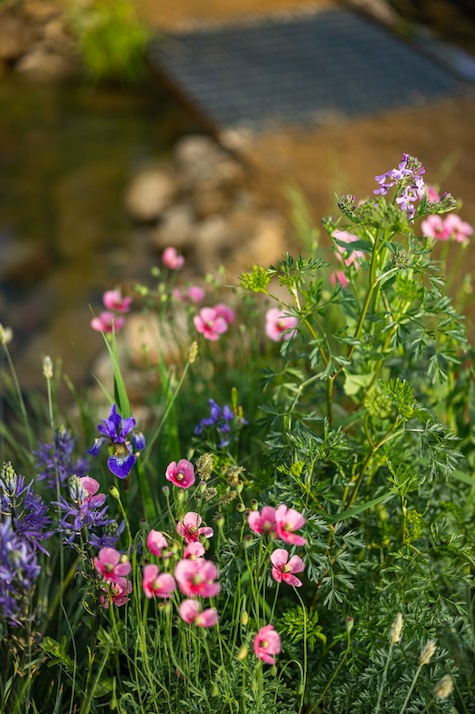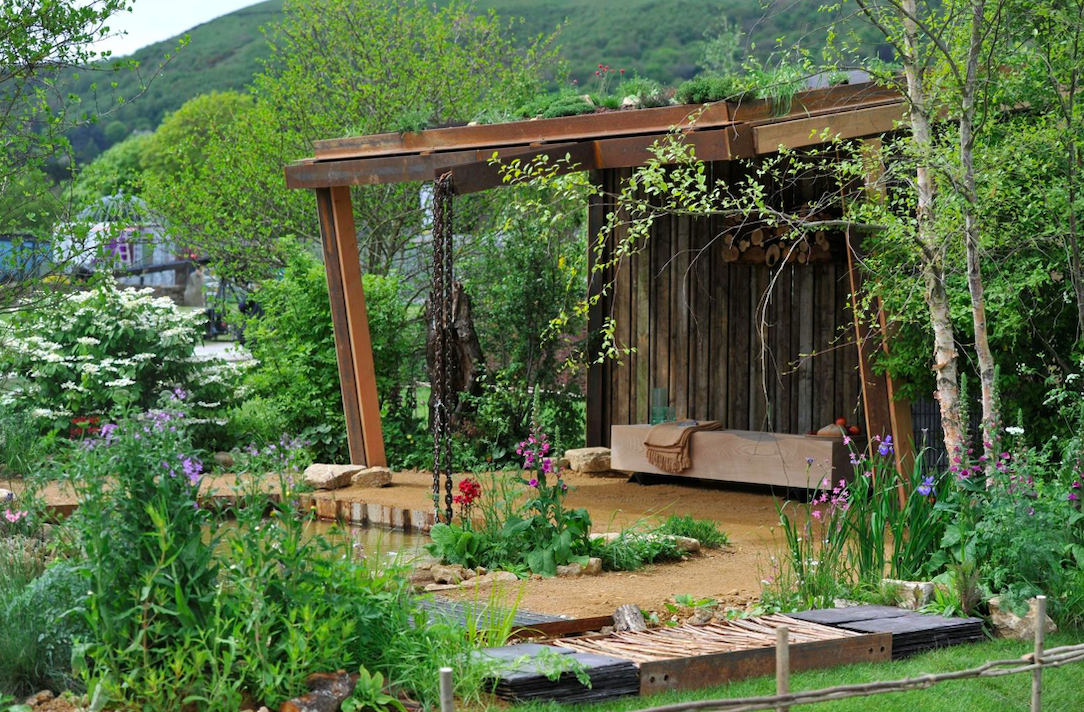Many of us want to make our gardens more wildlife-friendly creating habitats for wildlife to use but when it comes to incorporating suitable structures, ponds and safe places, we may come unstuck.
With his recent success at RHS Malvern Spring Show, I spoke to Oxfordshire based garden designer Jamie Langlands and asked him for his top tips on what went into creating The Wildlife Trusts: Wilder Spaces garden for which he won an astounding four awards: RHS Gold, Best in Show, the Best Construction award and the People’s Choice.
 Working with the brief he had received from the Berkshire, Buckinghamshire and Oxfordshire Wildlife Trust (BBOWT), Jamie was commissioned to create a wildlife friendly garden with improved biodiversity. The garden had to be crafted in such a way as to encourage more people to think carefully about how they design their own garden and the elements they should try to include. As many people prefer not to have a ‘wild’ looking garden, Jamie needed to create a wildlife garden which did not look like a wildlife garden.
Working with the brief he had received from the Berkshire, Buckinghamshire and Oxfordshire Wildlife Trust (BBOWT), Jamie was commissioned to create a wildlife friendly garden with improved biodiversity. The garden had to be crafted in such a way as to encourage more people to think carefully about how they design their own garden and the elements they should try to include. As many people prefer not to have a ‘wild’ looking garden, Jamie needed to create a wildlife garden which did not look like a wildlife garden.
So, what were the elements that had to be incorporated? “I was adamant from the outset that I wanted to create a garden using sustainable methods and recycled materials, including using zero cement or concreate. Also, the Wildlife Trust’s brief was wildlife had to be incorporated from the initial seed of an idea, ie, from the foundations to the finish.
When it came to the planting, I selected a mixture of non-native planting and native planting such as wild primroses (Primula vulgaris) and red campion (Silene diocia). I wanted to showcase how plants could be interspersed with what most people would terms as weeds, such as nettles (Urtica diocia) that provide a good food source for the larvae of butterflies, moths and other insects, and cow parsley (Anthriscus sylvestris). Cow parsley supports all kinds of insects including micro-moths, macro-moths, hoverflies, beetles and weevils. Using hedging such as native hawthorn (Crataegus monogyna) and blackthorn (Prunus spinosa) provides a home for numerous invertebrate species as well as autumn haws for birds to eat and attractive spring blossom. As well as cultivated perennials, I included wildflowers such as native primroses. Planting also had to be a mix of sparse and densely planted areas.
There was a requirement to include an area of water creating a mixture of habitats including shallow, shelved with banked sections to allow wildlife ease of access, still water and a bog area. We did this by forming a trickling creek which meandered towards a central pond, providing a source of shelter, habitat and water for a variety of species.”
A structure or building where wildlife could be viewed from also had to be included. “It was important that this structure formed an integral part of the design rather than adding it as an afterthought. The pavilion was made from recycled materials, with a living roof, nesting fascia and leaf-cutter bee towers signed into the structure. Other elements I had to incorporate were some form of dead wood, various substrates of varying heights and levels, and a way for insects to travel between the vital habitats. This was done by creating a compost trench where wildlife can safely travel below the path.”
As Jamie wanted to use recycled and sustainable materials, how easy would this be for people to incorporate in their garden?
 “Finding reclaimed materials for the garden was a wonderfully creative experience. Looking at ‘waste’ materials from a new perspective opened up a wealth of creative possibilities. When it came to using terracotta tiles, these were suddenly not just a tile but a way of creating habitats for wildlife. You can stack them, break them down and use as a substrate or crush them further and use them as a render or dressing. The materials are out there but you just need to develop a way of thinking laterally and exploring possibilities when it comes to using what you can find in alternative ways.”
“Finding reclaimed materials for the garden was a wonderfully creative experience. Looking at ‘waste’ materials from a new perspective opened up a wealth of creative possibilities. When it came to using terracotta tiles, these were suddenly not just a tile but a way of creating habitats for wildlife. You can stack them, break them down and use as a substrate or crush them further and use them as a render or dressing. The materials are out there but you just need to develop a way of thinking laterally and exploring possibilities when it comes to using what you can find in alternative ways.”
Creating a wildlife friendly garden doesn’t need to cost a lot of money so what are Jamie’s top tips? “It’s really as simple as leaving that old pile of rubble behind the shed or letting a section of your lawn grow long. Allow nettles to grow in a section of your garden and feel no shame but instead embrace them as they increase biodiversity within the space you’ve created. Take a look at the native plants which thrive in your local area and introduce some of those into your garden space, mixing them in with the cultivated perennials and shrubs to create a richly diverse thriving ecosystem.”
When it comes to designing a show garden on behalf of a client which will be built at a leading RHS Show, what were Jamie’s biggest challenges (apart from the weather). “Our plan was to create a mature space; one which looked as if it had existed for many years with details that can only be created with time, including paths naturally created by wildlife, moss growing in a naturalistic form – all of which gave a sense of history. Experimenting with traditional and new techniques gave the results we were aiming for.”
When a designer is given a brief with strict guidelines, there are always challenges associated with the client’s idea of what they are hoping to see as an end result. As a designer, however, each garden will be a learning experience and for Jamie, this wildlife garden was no exception: “Creating spaces that sit harmoniously with the surrounding landscapes whilst increasing biodiversity and ecosystems, made me look at materials that I select in an entirely new way. By looking at their intrinsic material value rather than their created purpose, this led me to be more creative as I was truly repurposing the material rather than the object itself.”
Estelle Bailey, BBOWT’s Chief Executive, said: “The Festival gave us a great opportunity to showcase to people what they can achieve in their own gardens for nature, for climate and for themselves. Nature is in crisis and not enough is being done to reverse this terrible decline. We want to see 30% of land well managed for nature by 2030 and our gardens are a vital part of that wild jigsaw to help bring nature back. Private gardens make up a bigger area than all of Britain’s nature reserves combined – they can provide a mosaic of mini-habitats that support a diverse range of species, so they are key to helping create more nature everywhere.”
If you are inspired to learn more about adapting your own garden or creating a wildlife friendly garden from scratch, take a look at the BBOWT website where further information on various aspects you can include is given.








